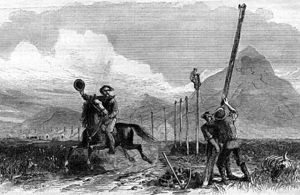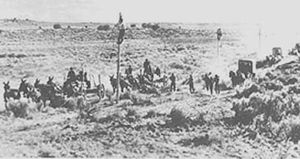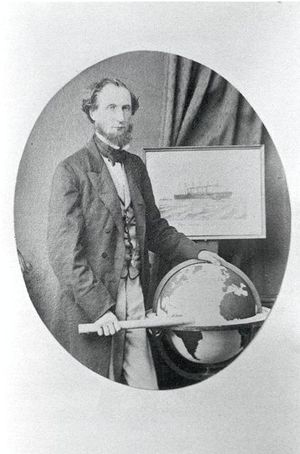Transcontinental Telegraph Line (U.S.)
The first transcontinental telegraph line was built in 1861 by the Western Union Telegraph Company. The line extended from Omaha, Nebraska to Carson City, Nevada and was the first high-speed link between California and the rest of the United States. It reached the West Coast eight years in advance of the transcontinental railroad. The original line was operated until May 1869 when the transcontinental railroad was completed and the telegraph lines were then moved to follow its route. The 1861 Transcontinental Telegraph is an IEEE Milestone
The telegraph, invented by Samuel Morse in the 1830s, was a major advance in the speed of communications. Before its invention, the time it took to send a message depended on the speed of horses or ships. For instance, it took 45 days to send a message from New York to San Francisco by ship, and over 20 days to send a message by overland stagecoach from St. Louis to San Francisco. The famous Pony Express took 11 days from St. Joseph, Missouri to Sacramento, California.
Just before the start of the Civil War, Congress offered a subsidy to any company agreeing to build the transcontinental telegraph.
The project was so risky that government support was necessary to convince investors to undertake it. On 20 September 1860, Hiram Sibley, president of Western Union, submitted a bid for $40,000 to build the line. Building began in Salt Lake City, Utah and moved both east and west. The Pony Express continued to cover the missing links as construction proceeded. The wire used was galvanized iron “of the best quality.” Insulators were an iron holder embedded in glass which in turn were enclosed in wooded forms. Poles were to be found “en route” (not so easily accomplished on the treeless plain). Western end materials were shipped around the Cape Horn to San Francisco. A wet cell provided 50 volts of power over a distance of 800 km (497 miles), which was unusually long because of low leakage due to low humidity.
The line was finished in October, 1861, just a few months after the onset of the Civil War. On 24 October, Stephen J. Field, Chief Justice of California and brother of Atlantic cable promoter Cyrus Field, sent a message to Abraham Lincoln assuring him of California’s loyalty to the Union and promising that the telegraph line would “be the means of strengthening the attachment which binds both the East and the West to the Union.” Like the advent of many technologies, the age of the telegraph signaled the demise of previous methods of communication. Once the telegraph connected the United States the famed and legendary Pony Express discontinued service.


